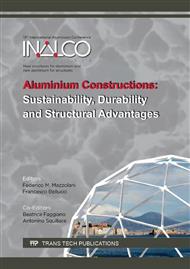[1]
M. Abbasi, A. Karimi Taheri, M.T. Salehi, Growth rate of interfacial compounds in Al/Cu bimetal produced by cold roll welding process. J Alloys Compd. 319 (2001) 233-241.
DOI: 10.1016/s0925-8388(01)00872-6
Google Scholar
[2]
J.P. Bergmann, F. Petzoldt, R. Schürer, S. Schneider, Solid-state welding of aluminium to copper-case studies. Weld World 57 (2013) 541-550.
DOI: 10.1007/s40194-013-0049-z
Google Scholar
[3]
R. Schäfer, P. Pasquale, Material hybrid joining of sheet metals by electromagnetic pulse technology. PST products GmbH, Alzenau, Germany: information on http: /www. pstproducts. com/EMPT_sheetwelding_PSTproducts. pdf.
Google Scholar
[4]
S.D. Kore, P. P Date, S.V. Kulkarni, Effect of process parameters on electromagnetic impact welding of aluminium sheets. Int J Impact Eng 34 (2007) 1327-1341.
DOI: 10.1016/j.ijimpeng.2006.08.006
Google Scholar
[5]
S. D. Kore, P. Dhanesh, S.V. Kulkarni, P.P. Date, Numerical modelling of electromagnetic welding. Int J of Appl Electrom 32 (2010) 1-19.
Google Scholar
[6]
J.K. Doley, S.D. Kore, Study of impact behavior of sheets in electromagnetic pulse welding. In: The 64th Annual Assembly of the International Institute of Welding, Chennai, India. The Indian Institute of Welding, CD-ROM Edition (2011).
Google Scholar
[7]
M. Watanabe, S. Kumai, High-speed deformation and collision behavior of pure aluminium plates in magnetic pulse welding. Mater Trans 50 (2009) 2035-(2042).
DOI: 10.2320/matertrans.l-m2009816
Google Scholar
[8]
M. Watanabe, S. Kumai, Interfacial morphology of magnetic pulse welded aluminium/aluminium and copper/copper lap joints. Mater Trans 50 (2009) 286-292.
DOI: 10.2320/matertrans.l-mra2008843
Google Scholar
[9]
A. Sterb, V. Shribman, A. Ben-Artzy, M. Aizenshtein, Interface phenomena and bonding mechanism in magnetic pulse welding. J Mater Eng Perform 23 (2014) 3449-3458.
DOI: 10.1007/s11665-014-1143-0
Google Scholar
[10]
R. Raoelison, M. Rachik, N. Buiron, D. Haye, M. Morel, B. Dos Santos, D. Jouaffre, G. Franz, Assessment of gap and charging voltage influence on mechanical behavior of joints obtained by magnetic pulse welding. In: Proceedings of the 5th International Conference on High Speed Forming, Dortmund, Germany, (2012).
DOI: 10.1016/j.jmapro.2012.04.001
Google Scholar
[11]
Y. Zhang, S. Suresh Babu, C. Prothe, M. Blakely, J. Kwasegroch, M. LaHa, G. Daehn, Application of high velocity impact welding at varied different length scales. J of Mater Process Tech 21 (2011) 944-985.
DOI: 10.1016/j.jmatprotec.2010.01.001
Google Scholar
[12]
M. Marya, S. Marya, D. Priem, On the Characteristics of Electromagnetic Welds between Aluminium and Other Metals and Alloys. In: The 57th annual Assembly of the International Institute of Welding, Osaka, Japan (2004).
DOI: 10.1007/bf03263412
Google Scholar


